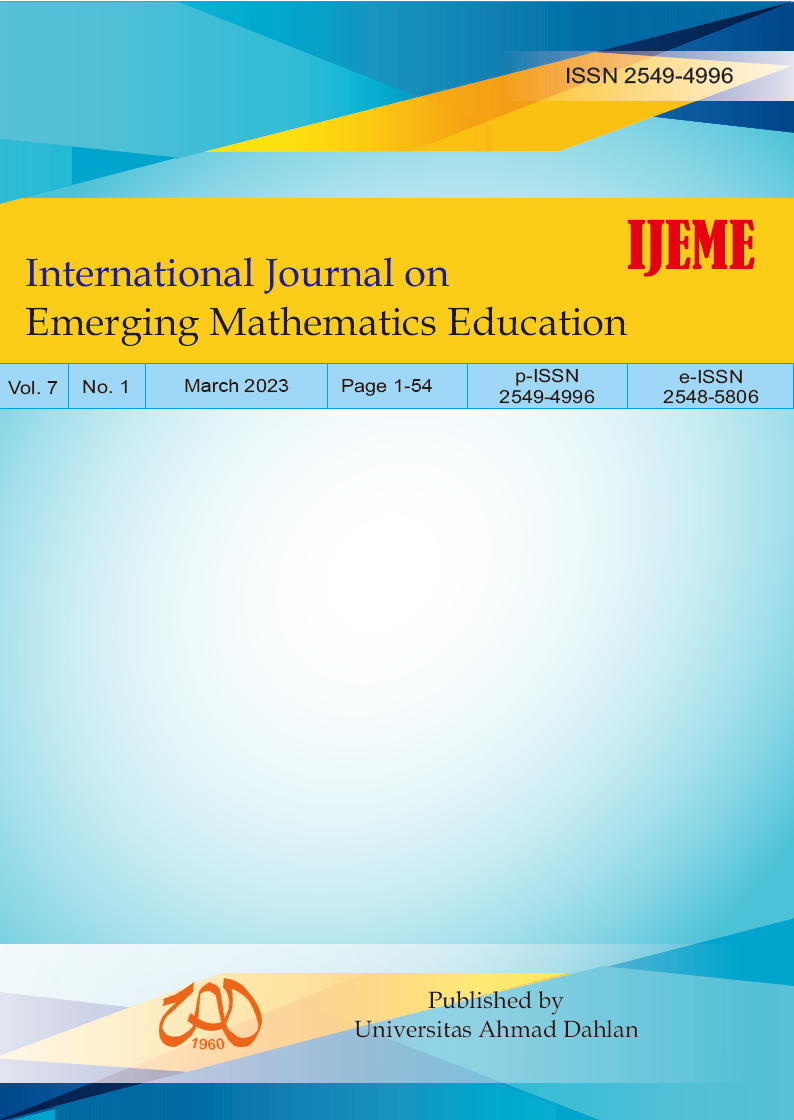Contextualizing Probability Tasks: The Case of Egyptian School Curriculum
DOI:
https://doi.org/10.12928/ijeme.v7i1.25575Keywords:
Teaching Statistics, Context, ProbabilityAbstract
This paper clarifies contexts of probability in Egyptian primary and lower-secondary school textbooks and how the students prioritize them. Through a preliminary general inductive analysis, it was apparent that the Egyptian curriculum emphasized the conventional activities that require calculations and are suitable to employ theoretical probability. On the other hand, students highlighted the environmental circumstances, such as predicting the weather, to be the most practical context for the probability. Accordingly, refinement of the curriculum is needed to be consistent with students’ viewpoints.
References
Batanero, C., Contreras, J. M., Fernandes, J. A., & Ojeda, M. M. (2010). Paradoxical games as a didactic tool to train teachers in probability.
Borovcnik, M. (2012). Conditional probability–a review of mathematical, philosophical, and educational perspectives. Topic Study Group, 11.
Chassapis, D., & Chatzivasileiou, E. (2008). Socio-cultural influences on children’s conceptions of chance and probability. In Mathematics Education and Society Conference (p. 197).
Chaudhary, G. K. (2015). Factors affecting curriculum implementation for students. International journal of applied research, 1(12), 984-986.
Cobb, G. W., & Moore, D. S. (1997). Mathematics, statistics, and teaching. The American mathematical monthly, 104(9), 801-823.
Devlin, K. (2014). The most common misconception about probability. Probabilistic thinking: Presenting plural perspectives, ix-xiii.
Dollard, C. (2011). Preservice elementary teachers and the fundamentals of probability. Statistics education research journal, 10(2), 27-47.
Elbehary, S. G. (2021). Reasoning under uncertainty within the context of probability education: A case study of preservice mathematics teachers. Pythagoras, 42(1), 630.
Garfield, J., & Ahlgren, A. (1988). Difficulties in learning basic concepts in probability and statistics: Implications for research. Journal for research in Mathematics Education, 19(1), 44-63.
Grenon, V., Larose, F., Bourque, J., & Bédard, J. (2010). The Impact of Using Pupils’ Daily Social Practices as Well as Computerized Simulators as a Teaching Medium on Motivation and Knowledge Construction Regarding Probabilities Among High School Pupils. Data and context in statistics education: Towards an evidence-based society. International Statistical Institute.
Kazak, S., & Confrey, J. (2006, July). Elementary school students’ informal and intuitive conceptions of probability distributions. In Proceedings of the Seventh International Conference on Teaching Statistics, Salvador, Brazil: International Statistical Institute and International Association for Statistical Education. Online: http://www. stat. auckland. ac. nz/~ iase.
Larose, F., Bourque, J., & Freiman, V. (2010, July). The effect of contextualising probability education on differentiating the concepts of luck, chance, and probabilities among middle and high school pupils in Quebec. In Data and context in statistics education: Towards an evidence-based society. Proceedings of the Eighth International Conference on Teaching Statistics (ICOTS8).
Liberman, V., & Tversky A. (1996). Critical thinking (in Hebrew). Tel-Aviv: The Open University of Israel.
Musch, J., & Ehrenberg, K. (2002). Probability misjudgment, cognitive ability, and belief in the paranormal. British Journal of Psychology, 93(2), 169-177.
Robitaille, D. F., & Travers, K. J. (1992). International studies of achievement in mathematics.
Stohl, H. (2005). Probability in teacher education and development. In Exploring probability in school: Challenges for teaching and learning (pp. 345-366). Boston, MA: Springer US.
The Arab Republic of Egypt, Ministry of Education and Technical
Education. (2020). Mathematics for primary 3.
Thomas, D. R. (2006). A general inductive approach for analyzing qualitative evaluation data. American journal of evaluation, 27(2), 237-246.
Gómez, E., & Contreras, J. M. (2014, July). Meanings of probability in Spanish curriculum for primary school. In Sustainability in statistics education. Proceedings of the Ninth International Conference on Teaching Statistics.
Watson, J. (2005). The probabilistic reasoning of middle school students. In Exploring probability in school: Challenges for teaching and learning (pp. 145-169). Boston, MA: Springer US.
Weiland, T. (2017). The importance of context in task selection. Teaching Statistics, 39(1), 20-25.
Wild, C. J., & Pfannkuch, M. (1999). Statistical thinking in empirical enquiry. International statistical review, 67(3), 223-248.
Downloads
Published
How to Cite
Issue
Section
License
License and Copyright Agreement
In submitting the manuscript to the journal, the authors certify that:
- They are authorized by their co-authors to enter into these arrangements.
- The work described has not been formally published before, except in the form of an abstract or as part of a published lecture, review, thesis, or overlay journal. Please also carefully read the International Journal on Emerging Mathematics Education (IJEME) Author Guidelines at http://journal.uad.ac.id/index.php/IJEME/about/submissions#authorGuidelines
- That it is not under consideration for publication elsewhere,
- That its publication has been approved by all the author(s) and by the responsible authorities, tacitly or explicitly, of the institutes where the work has been carried out.
- They secure the right to reproduce any material that has already been published or copyrighted elsewhere.
- They agree to the following license and copyright agreement.
Copyright
Authors who publish with the International Journal on Emerging Mathematics Education (IJEME) agree to the following terms:
- Authors retain copyright and grant the journal the right of first publication with the work simultaneously licensed under a Creative Commons Attribution License (CC BY-SA 4.0) that allows others to share the work with an acknowledgment of the work's authorship and initial publication in this journal.
- Authors are able to enter into separate, additional contractual arrangements for the non-exclusive distribution of the journal's published version of the work (e.g., post it to an institutional repository or publish it in a book), with an acknowledgment of its initial publication in this journal.
- Authors are permitted and encouraged to post their work online (e.g., in institutional repositories or on their website) prior to and during the submission process, as it can lead to productive exchanges, as well as earlier and greater citation of published work.
![]()
Ciptaan disebarluaskan di bawah Lisensi Creative Commons Atribusi-BerbagiSerupa 4.0 Internasional.





